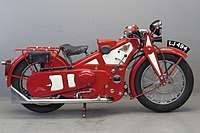Ascot-Pullin 500
The Ascot-Pullin 500 was a motorcycle made by Ascot-Pullin Motorcycles in Letchworth, Hertfordshire in 1928.[1] As an updated version of the Pullin motor bicycle of 1919,[3] the Ascot-Pullin 500 overhead valve single was the first time hydraulic brakes were used on a motorcycle.[4]
 Right side of a 1929 Ascot-Pullin 500 | |
| Manufacturer | Ascot-Pullin Motorcycles |
|---|---|
| Production | 1928-1930[1] |
| Predecessor | Pullin-Groom |
| Engine | 496 cc (30.3 cu in) air-cooled OHV single |
| Top speed | 70 mph (110 km/h)[2] |
| Power | 17 bhp (13 kW)[2] |
| Transmission | Three speed chain final drive |
| Suspension | Pressed steel girder front, rigid rear |
| Brakes | Drum front and rear |
| Weight | 330 lb (150 kg) (dry) |
History
In 1919, British inventor Cyril Pullin and Stanley L. Groom produced the Pullin motor bicycle,[3] a wheeled machine that included a novel two-stroke engine and extensive manufacture use of steel pressings that anticipated developments by British motorcycle manufacturer Ariel Motorcycles in the late 1950s and Japanese motorcycle manufacturers in 1960s.[3] The bicycle was patented in 1920.[3] Since 1920, Pullin had been working with Stanley Groom to develop and patent a two-stroke motorcycle with a unique design of pressed sheet metal frame and forks. After working on a range of other inventions including the Ascot, Pullin teamed up with Groom again to further develop their ideas and patent the Ascot Pullin motorcycle, with a four-stroke rather than two-cycle engine.[5] At a time when manufacturers were taking a very traditional approach to motorcycle design with conventional frames and engine layout, Pullin and Grom were keen to create an enclosed feel by mounting the engine horizontally within a pressed-steel frame. As well as the hydraulic brakes, Pullin also designed a telescopic centre stand and an adjustable windshield, complete with a windscreen wiper and rear-view mirror, as well as a fully enclosed chain and interchangeable wheels.[2]
With estimated 17 bhp (13 kW), the Ascot-Pullin was capable of 70 mph (110 km/h), but approximately 400 to 500 were produced, so few survive to this day.[1][2]
Pullin's influence can be seen in the emergence of the Ariel Leader and the Vincent Black Prince thirty years later, which both developed the enclosed concept in an attempt to attract a wider range of customers. As with the Ascot-Pullin, however, the fully enclosed look has never really led to high volume sales but instead attracts a niche market.
At present, the U.S. National Highway Traffic Safety Administration recognizes that the first hydraulic brakes on motorcycles occurred in 1952.[6]
See also
References
- "Ascot Motor and Manufacturing Co". GracesGuide.co.uk. Grace's Guide Ltd. Archived from the original on 28 March 2019. Retrieved 28 March 2019.
- Brown, Roland (1 September 1999). The History of British Bikes (hardback). Bath, United Kingdom: Parragon Plus. ISBN 978-0-752-53153-3. OCLC 42578944. OL 10821108M.
- "Pullin motor bicycle, 1919". Science and Society Picture Library. Science Museum. 2004. Retrieved 6 December 2008.
- Chadwick, Ian. "Ascot-Pullin". Archived from the original on 11 December 2008. Retrieved 1 December 2008.
- Kephart, Douglas. "Researching the Douglas Patents". Retrieved 3 December 2008.
- U.S. National Highway Traffic Safety Administration (2000). National Agenda for Motorcycle Safety. Washington, D.C.: United States Department of Transportation. p. 1983. Retrieved 6 December 2008.
External links
| Wikimedia Commons has media related to Ascot-Pullin 500. |
- Ascot-Pullin at Grace's Guide to British Industrial History